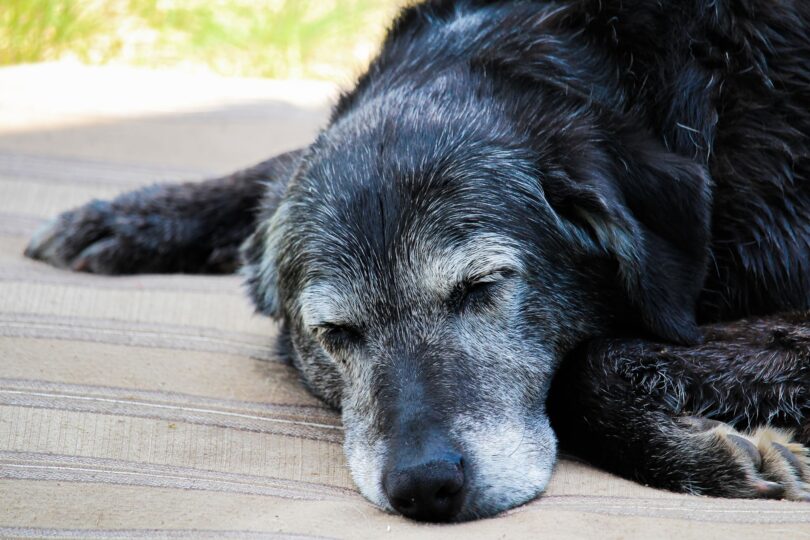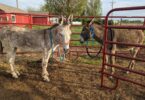Note: This article was originally published on our sister site Love & Let Go.
Farm Life…Without Fido
Your puppy has been by your side since the early days—maybe even born in one of your horse stalls. She has wagged her tail through all of life’s ups and downs. She has snuggled and cuddled you on hard days and made you laugh with her antics on countless trail rides.
She is your best friend, and you have a bond unlike any other.
As much as we wish they could, our furry family members can’t live forever. When they become sick or struggle with severe pain, we may face the decision of waiting for them to pass on their own time or ending their suffering through euthanasia.
Neither is an easy decision, and both weigh heavily on the heart. But when your beloved barn dog is ready to cross the rainbow bridge, you can find peace in your decision.
Euthanasia is Not Simply Ending Your Dog’s Life
Euthanasia can be a painless and peaceful way to end your dog’s suffering.
Also known as “putting down” or “putting to sleep,” euthanasia involves a veterinarian using medication to gently stop a dog’s heart.
While this process ends your pet’s life, it also ends its suffering.
The decision to euthanize any dog (even outdoor dogs that may not spend much time in the house) is a difficult one, but in many cases it’s also the most compassionate and loving thing you can do for your canine companion. While losing your farm dog can be heart-wrenching, watching them suffer is worse.
Choosing euthanasia is not giving up on your dog.
Instead, it is loving her enough to not let her live an unhappy life in pain and suffering.
Only You and Your Dog Can Make the Decision
No one wants to see a beloved dog suffer in pain or be so sick that they lose interest in the things they love—chasing barn cats, trotting alongside you on the trail, or gathering the cows. At the same time, making the decision to euthanize a dog is not something we want to make either.
While your veterinarian may let you know that the time has come to let your dog cross over, the final decision is ultimately up to you.
In many ways, our dogs let us know when the sickness or pain becomes too much.
Some signs that it may be time to discuss euthanasia with your vet include:
- Your dog is experiencing severe pain. While difficulty moving or the unwillingness to move is often a clear sign of pain, it isn’t the only way our dogs can let us know they are in pain. Other common signs can include not wanting to be touched, whining or crying when touched, excessive licking, restlessness, unexplained aggression, changes in panting or breathing, or increased vocalization.
- Experiencing frequent vomiting or loose bowels that result in recurring dehydration and weight loss.
- Loss of interest in food, treats, and eating in general. In many cases, an ill pup may refuse any food at all. The only way they will eat is when force-fed.
- Complete loss of interest in her favorite activities. When she begins leaving her toys behind, no longer gets up to greet you when you get home, and no longer seeks attention.
Take Some Time to Prepare
If your pup is suffering, euthanasia is a way to peacefully and painlessly end her suffering. When you make the difficult decision, it is a good idea to take some time to prepare, both mentally and with your veterinarian.
Saying goodbye to your best friend is difficult and will take time.
Your vet may agree you can take a few additional days to spend with your dog, doing her favorite things, taking her to her favorite trailhead, or simply enjoying quality time at the barn.
If you have children, take time to explain what is happening and help them understand, as well as help them prepare for the loss.
Make Arrangements Ahead of Time
Before you make the appointment for euthanasia, you have some decisions to make.
While the vet’s office is an option, home euthanasia veterinarians can come into your farm and let your pup pass in her own bed, her familiar surroundings, and comforted by family.
Many view home euthanasia as a more natural way for their dogs to cross over.
It can avoid the stress that many dogs experience at the vet’s office, and you are in your own home where you both feel more comfortable. Before you schedule the appointment, whether at home or at the vet, make afterlife arrangements.
We don’t recommend leaving this until after your dog passes. Your vet’s office may offer cremation services or the ability for a personal burial.
Have these arrangements in place.
Another important decision is if you want to be present when your dog passes. For some, this may be too difficult. Others feel that they want to be the last person their dog sees before she passes and want to be with her right until the end.
There is no right or wrong decision and you should choose what you feel most comfortable with.
What Happens During Euthanasia?
Many people worry that euthanasia will hurt or be difficult for their dog.
The truth is, it is very much like falling asleep, hence “putting to sleep.” When the time comes, your veterinarian will likely administer a mild sedative. This helps your pet relax and makes the process much easier on both you and your dog.
Your dog will then be calm, and any stress reduced well before the second injection.
The veterinarian administers the second injection once you are ready. Within a few seconds, your dog will begin taking deeper breaths before slipping into what looks like a deep sleep.
At this point, your vet will give you some time to say your final goodbye. Then, your dog’s heart will stop beating.
Despite how you feel in the moment, your heart will continue on.
The Grieving Process Takes Time
There is no right of wrong way to handle the loss of a cherished farm dog. It is a very personal experience that can take time.
Your dog played an important role in your life (even in your business), and their loss will leave an empty space in your heart.
For those looking for support, pet loss groups can provide comfort as well as allow you to share your love for your dog.
P.S. If you found this article helpful, check out:
- Canine Empathy: Can Barn Dogs Sense Sadness?
- Barn Dog Pain Solutions 101 (Home Remedies, Holistic, etc.)
- Dogs in Distress: Do Barn Dogs Grieve?
- My barn dog isn’t eating. Should I be worried?
- Preparing for Peace: What it Means to Euthanize a Barn Dog
- Fox Hunting Fidos: Beagle Life Stages and Average Lifespan







